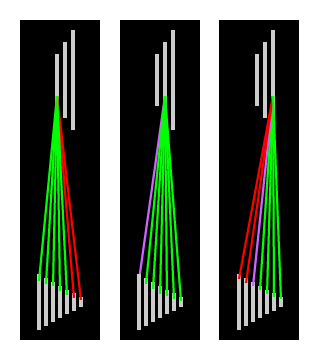It seems that on my mountain bike and all other multispeed bikes I have seen having a rear cassette or freewheel all have sloped cogs, meaning they go from largest to smallest in order of decreasing size (such as 28,24,22,20,18,16, and 14 in my case). Problem is that basically creates a triple range 7 speed, not really a 21 speed. Also some combinations are not recommended cuz of a diagonal chain and some are duplicates normally and many combinations are very close so they are not really a unique gear ratio. Also, to get progressive gearing, the rider has to shift in a funky order to get increasing gear ratios.
To help alleviate these, I had an idea but not sure if it would work. Basically you would still have a triple chainring but 9 cogs in the back. The idea is you use 3 cogs with each chainring. So chainring A (the granny gear) only engages cogs 1,2, and 3 (the 3 largest cogs). Then when shifting to gear 4, you shift to chainring B (the middle size chainring) and cog # 4. Here is the variation though. Since the front chainrings might be 24,32,40 and assuming the rear cogs are 28,24,22,20,18,16,14, we would be jumping from 24/22 = 1.09 to 32/20 = 1.60 which is a huge jump. To help alleviate this I was wondering if the rear cogs can be "staggered" such that even with the larger chainring every 3 gears, the overall gearing would be progressive and consistent (no big jumps). For example, 3rd gear can be 24/22 which is about 1.09 and 4th gear could be 32/25 which is 1.28. So when shifting from 3rd gear to 4th gear, the front chainring size goes up 8 teeth but the rear cog also goes up 3 teeth, thus eliminating the large change in ratio and making it more mild. So the 3+9 setup would effectively be a true progressive 9 speed bike but with better chain alignment than a 1x9 setup since the front 3 chainrings would be aligned with cogs 2,5, and 8, thus never being misaligned more than about 1 chain width so the chain will be almost always straight (not diagonal).
So my question is can a rear cassette have cogs like this that are not sloped all the same such as 28,24,22,25...? Will it shift ok or are cogs only designed to be "progressively sloped" and not mixed like in my idea?
Addendum: Also with my idea, it would allow 12 speed cassettes since each front chainring could engage 4 rear cogs. The front chainrings could be aligned with cogs 2.5, 6.5, and 10.5, thus never being misaligned more than about 1.5 chainwidths. A progressive 12 speed could have both reasonably close gear ratios and wide range. My ideal overall range for a bike (to cover almost all circumstances) would be 0.5 for the low gear (13 gear inches for a 26" rear tire) up to 4.0 (104 gear inches for 26" rear tire). I could design a 12 speed to cover that range. It would require about 20% change in each successive gear unless you had a big jump for the lowest gear, then you could slightly tighten up the other gears to perhaps 18% or so.



